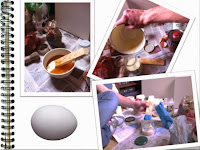
 En este post explicaré para quién le sirva como hacer dos tipos de pintura al temple que aprendí en
En este post explicaré para quién le sirva como hacer dos tipos de pintura al temple que aprendí enun curso sobre técnicas y procedimientos de la
pintura.
La pintura al temple era una técnica ya conocida por el mundo clásico y fié el medio más utilizado en el mundo bizantino, en la época medieval y en el renacimiento europeo desde su desarrollo a partir de la pintura encáustico. Como ejemplo de los grandes que usaban esta técnica encontramos al maestro Michelangelo que pintaba usando el temple al huevo. Más tarde la pintura al temple sería eclipsada por la plasticidad que ofrecía el óleo.
La pintura al temple se seca muy rápido. Normalmente se aplica a capas finas o transparentes y una vez seca produce un efecto fino y mate. Ya que no se puede aplicar a capas gruesas, como se hace en el óleo, el temple no puede llegar nunca a la saturación que se consigue con el óleo. Y a continuación explicaré dos técnicas diferenciadas del temple.
- temple acrílico
- temple resinoso.

La receta del TEMPLE ACRÍLICO:
-BASE ACRÍLICA
-PIGMENTOS UNOS 100gr O 150 gr POR COLOR.
-RECIPIENTES PARA LOS COLORES ( No muy grandes para que no queden muy vacíos).
-UNA botella para EL AGLUTINANTE.
Proporción General:
250grs. de Látex
3/4 de litro de agua
LA RECETA DEL TEMPLE GRASSO-RESINOSO
-BARNIZ DE DAMMAR 1/2, 150 gr aprox de resina de dammar, 200ml esencia de trementina.

-HUEVOS (1/2 docena).
-ACEITE DE LINAZA (crudo 250ml)
-ACEITE DE LINAZA PREPOLIMERIZADO.( 250 ml)
-BASE ACRILICA ( 150 ml).
Es muy fácil, simplemente hay que mezclar los ingredientes con la proporción aproximada que he puesto, el orden no es demasiado importante, cuando el pigmento quede más o menos denso, ya lo tenemos. En el caso del temple al huevo hay que guardarlo en una nevera o a los pocos meses empezará a oler muuy mal. :)

jordi machi.
ENGLISH VERSION.
In this post I will explain for whom I serve as do two types of tempera painting I learned in
a course on techniques and procedures
painting.
Tempera painting was a technique already known to the classical world behind Marriott and the most used in the Byzantine world, in the Middle Ages and European renaissance since its development from the encaustic painting. As an example of the great who used this technique to find the master Michelangelo painted using egg tempera. Later tempera paint would be eclipsed by the plasticity featuring oil.
The tempera paint dries very quickly. Usually applied to thin or transparent layers and produce after drying and fine matte effect. Since you can not apply a thick layer, as in oil, tempering can never reach saturation is achieved with the oil. And then I will explain two different quenching techniques.
- Acrylic temple
- Resinous temple.
ACRYLIC TEMPLE recipe:
-BASE ACRYLIC
UNOS-100gr PIGMENTS COLOR OR 150 gr.
COLORS-CONTAINERS (not very big so there are no very empty).
A bottle-EL BINDER.
General Proportion:
250g. Latex
3/4 liter of water
RECIPE OF TEMPLE-RESINOUS Grasso
Dammar-VARNISH 1/2, 150 gr approx dammar resin, turpentine 200ml.
-EGGS (half dozen).
-FLAX OIL (oil 250ml)
FLAX OIL-prepolymerised. (250 ml)
-BASE ACRYLIC (150 ml).
It is very easy, you just have to mix the ingredients with the approximate ratio I put the order is not too important, when the pigment remains more or less dense, I have. In the case of egg tempera must save it in a refrigerator or a few months muuy begin to smell bad. :)
jordi machi.









No hay comentarios:
Publicar un comentario